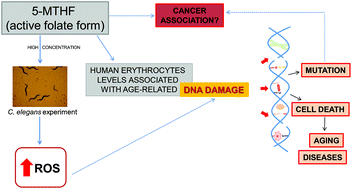DNA damage in the elderly is associated with 5-MTHF levels: a pro-oxidant activity
Abstract
The aging phenomenon is associated with oxidative stress damage in biomolecules, especially DNA. 5-Methyltetrahydrofolate (5-MTHF), the active folate form, plays a pivotal role in maintaining genomic integrity. However, recently it was associated with cancer development. In Brazil, there are folic acid enriched foods, such as flour, making the general population chronically exposed to folates. Therefore, the aim of this study was to investigate whether erythrocytes 5-MTHF levels were associated with age-related DNA damage in two groups (elderly and young subjects). Additionally, a study in Caenorhabditis elegans, an in vivo alternative model, was performed to verify if 5-MTHF presents a pro-oxidant effect. A total of 50 elderly and 25 young subjects participated in this study, which analyzed whole blood DNA damage, plasma carbonyl proteins (PCO), and erythrocytes 5-MTHF levels. In addition, ROS and RNS production, survival rate, and lifespan were performed in C. elegans exposed to 5-MTHF. Blood 5-MTHF levels and DNA damage were increased in the elderly compared to the young group. A positive association was found between 5-MTHF levels and DNA damage, and between DNA damage and PCO levels, suggesting an oxidative cause of damage associated with the active folate form. In an experimental study it was observed that 5-MTHF increased ROS production in C. elegans, in a dose dependent manner, while survival rate and life span were not affected at the test doses. These findings suggest that 5-MTHF, the active folate form, may be involved in DNA damage in the elderly. This damage could be a result of oxidative stress, as observed in the in vivo alternative model; however, more studies are necessary to prove our present results.



 Please wait while we load your content...
Please wait while we load your content...